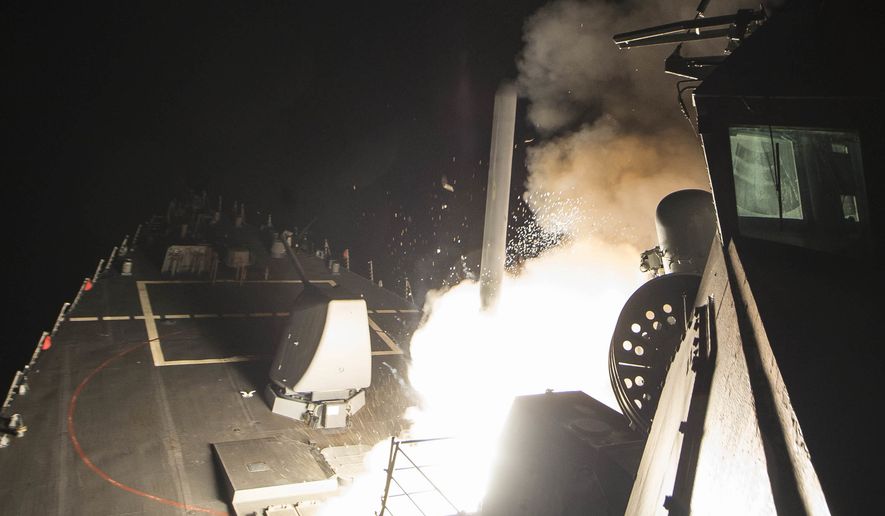American warships stationed off the Syrian coastline fired a salvo of cruise missiles against a Syrian military base in the western part of the country, days after a regime chemical strike left nearly 100 civilians wounded or dead.
59 Tomahawk cruise missiles were fired as part of the attack early Friday morning, U.S. officials said. The strikes were centered on the al Shayrat airfield near the western Syrian city of Homs, located in the Alawite-dominated region of the country.
The Arleigh-Burke class destroyers U.S.S. Porter and U.S.S. Ross launched the attacks from locations in the eastern Mediterranean Sea, Pentagon spokesman Capt. Jeff Davis said Thursday night. “As always, the U.S. took extraordinary measures to avoid civilian casualties,” he said in a statement. “Every precaution was taken to execute this strike with minimal risk to personnel at the airfield.”
Initial damage assessments show Syrian aircraft and support facilities at the airfield had been destroyed, “reducing the Syrian Government’s ability to deliver chemical weapons,” Capt. Davis said.
The airfield was one of the locations suspected of housing portions of the chemical weapons stockpiles used during Tuesday’s attack near Idlib province, a known stronghold for rebel forces battling to overthrow President Bashar Assad.
“The U.S. intelligence community assesses that aircraft from Shayrat [airfield] conducted the chemical weapons attack on April 4,” Capt. Davis said. “The strike was intended to deter the regime from using chemical weapons again.”
SEE ALSO: Donald Trump: Syria strike in ‘vital national security interest’ of U.S.
Prior to the chemical attack in Idlib, Syrian forces were required to dismantle all chemical weapons stockpiles as part of Russian-brokered peace deal between Washington and Damascus in 2014. The Assad regime has used chemical weapons against rebel forces three times, including Tuesday’s strike, since the 2014 deal.
American commanders warned their Russian counterparts of the impending strike near Homs, which is just over 100 miles south of Latakia, Moscow’s main military hub in the country, according to the Pentagon. “U.S. military planners took precautions to minimize risk to Russian or Syrian personnel located at the airfield,” Capt. Davis said.
U.S. and Russian commanders have kept close communications since Moscow began its Syrian operations in support of the Assad regime in earnest. Moscow and Washington say the communications were strictly designed to ensure American and Russian air assets do not interfere with each other’s operations.
Republican Sens. John McCain and Lindsey Graham, longtime proponents of U.S. intervention in Syria, lauded the White House’s decision to act. The strikes “have sent an important message the United States will no longer stand idly by as Assad, aided and abetted by Putin’s Russia, slaughters innocent Syrians with chemical weapons and barrel bombs,” they said in a joint statement.
Florida Republican and former GOP presidential hopeful Sen. Marco Rubio also commended the administration for taking action in Syria, noting “President Trump has made it clear to Assad and those who empower him that the days of committing war crimes with impunity are over,” he said in a statement.
But others in Congress voiced concern over the move, arguing the strikes were launched without proper congressional authority — a claim Hill Republicans levied often against the Obama White House for its military actions in Libya in 2011.
SEE ALSO: Syria, Russia condemn U.S. ‘aggression’ after strike on air base; Israel supports
“The President needs Congressional authorization for military action as required by the Constitution. Our prior interventions in this region have done nothing to make us safer and Syria will be no different,” Kentucky Republican Sen. Rand Paul tweeted late Thursday night.
House California Republican Rep. Ted Lieu was more succinct in his criticism of the Syrian strikes, calling them unconstitutional, due to the lack of congressional approval.
Illinois Democrat Sen. Dick Durbin conceded the White House’s “measured response” Thursday to the Syrian regime’s recent use of chemical weapons. But Sen. Durbin, the No. 2 Democrat in the upper chamber, warned the Trump administration that any further military action against Syria will demand “close scrutiny from Congress … [and] require engaging the American people in that decision.”
The situation reached a tipping point Thursday, as President Trump and Secretary of State Rex Tillerson suggested the White House was weighing military action against Mr. Assad. The U.S. strikes in Homs is the first major military action taken by the Trump administration.
Mr. Tillerson said that “there is no doubt in our minds and the information we have supports that Syria — the Syrian regime under the leadership of President Bashar al-Assad are responsible” for the chemical attack that occurred Tuesday.
The secretary of state made the comments hours before Mr. Trump and Defense Secretary James Mattis were scheduled to review options for a potential U.S. military retaliation against Syria.
Earlier on Thursday, Mr. Trump raised eyebrows by suggesting “something should happen” to punish the Syrian president; Mr. Tillerson went further — suggesting the administration has reversed its position on whether Mr. Assad can remain in power and calling on Russia to back away from him.
“It is very important that the Russian government consider carefully their continued support for the Assad regime,” Mr. Tillerson told reporters gathered at the president’s Mar-a-Lago resort in Florida, where he and Mr. Trump began a two-day summit with Chinese President Xi Jinping on Thursday.
• Guy Taylor contributed to this article.
• Stephen Dinan can be reached at sdinan@washingtontimes.com.
• Carlo Muñoz can be reached at cmunoz@washingtontimes.com.




Please read our comment policy before commenting.